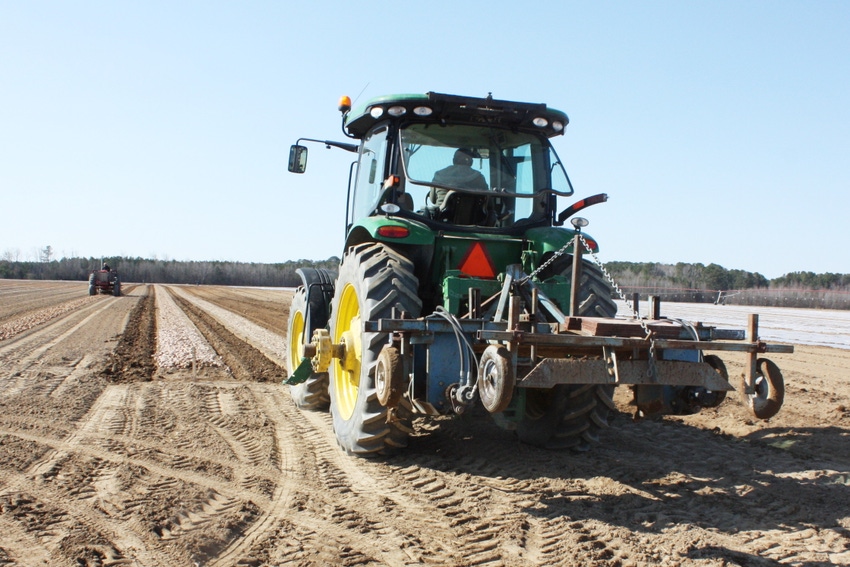March 11, 2015

Farmers who attended the many shows and meetings held in January and February faced a gut-wrenching question: What crops can you afford to make investments in for new production equipment in an environment of declining commodity prices?
But some commodities were holding up relatively well, said Tony Jackson, vice president of sales for Kelley Manufacturing Co. of Tifton, Ga.
In a Feb. 5 interview at the Southern Farm Show in Raleigh, N.C., Jackson said one of the winners is peanuts. “Peanuts seem to have gotten favorable treatment in the farm bill,” he said. “Right now, we are selling a lot of equipment to peanut growers.”
The elements of peanut appeal in 2015 were laid out in a presentation at the Georgia Economic Outlook Series in Albany, Ga., also on February 5.
“Right now that seems to be the most attractive thing for producers to plant,” said Mark Masters, director of the Georgia Water Planning and Policy Center at Albany State University.
One of the reasons is the provision of the recent farm bill which provides a safety net for peanut growers through price loss coverage.
“When all else fails, plant peanuts,” Masters advised southwest Georgia farmers. “Last year, we planted about 600,000 acres of peanuts. I think—price driven—I think we are going to see some more of that shift in 2015.
Given the price of alternatives, mainly corn and cotton – soybeans to some extent – I think farmers are going to plant upwards of 700,000 acres. It is by far the most attractive crop by far right now, given what we grow.”
Animal agriculture still is appealing to farmers also.
“The one thing that remained a very bright spot was animal agriculture, particularly cattle,” Masters said. “We saw record highs in 2014 for those producers. The cattle market set some additional highs in the month of January, and I am not sure if we have seen the peak.”
Jackson said that poultry appeared to be a frequent choice for growers in the Southeast who need to shift resources into another commodity.
Cotton was still a mystery at the end of the first week of February, with the perplexing situation of the Chinese inventories on everyone’s mind: China reportedly has a very large surplus of cotton in storage, and reportedly there are quality problems.
“Cotton deteriorates over time,” said Jackson. “What are they going to do with it, and what effect will it have on the world market?”
Sweet potatoes are also attracting some interest,” he said. “I heard from a Mississippi grower who will plant some sweet potatoes for the first time this year.”
Overproduction?
Consumers have continued their brand for the healthful flesh of the sweet potato, Sue Johnson-Langdon, executive director of the North Carolina Sweet Potato Commission.
And another factor is developing: Before the end of this year, North Carolina is expected to have three sweet potato dehydrating facilities. “The product of these plants can be used in pet food or nutrition bars,” said Langdon-Johnson.
“There is a demand for vegetable starch now, and dehydrated sweet potato might help meet it. But we hope there isn’t too much optimism. It would be easy for our growers to plant too many acres. We just hope growers don’t over calculate the numbers it will take to meet the demand.”
North Carolinians planted a record acreage of 72,000 acres of sweet potatoes in 2014, she said.
Serious thinking
The farmers who visited the exhibit of MarCo Mfg. of Bennettsville, S.C., which specializes in tobacco machinery, were looking for ways to improve their operations. “The frame of mind of the farmers who stopped by was better than I thought it would be,” said Tom Pharr, MarCo’s chief executive officer, in an interview at the Raleigh show. “There was some serious thinking going on.”
As one might think in a season like this, some growers were looking for ways to upgrade existing equipment rather than buying new ones. MarCo was able to help. “We have some upgrade equipment for older machines,” said Pharr, including a cutter bar upgrade kit and a barn curing control update kit.
Pharr isn’t expecting big things in tobacco machinery sales this year but thinks pessimism may not be in order. “I fully expect 2015 to be an off year, but I don’t expect it to be far off,” he said.
Sweet potatoes and tobacco
The TriEst Ag Group of Greenville, N.C., heard from both sides of the commodity price gap at the Raleigh show, since two of the company’s services are fumigation of sweet potato and tobacco fields. “A lot of our tobacco-farming customers are still wondering on contracts,” said Patrick McLawhorn of TriEst. “It is hard to put a finger on just where the cuts [in contracting] will fall.”
TriEst also provides fumigant to Canadian tobacco growers and does contract fumigation for strawberry nurseries in the higher elevations of western North Carolina. “It is a little like the old tobacco seedbeds,” said McLawhorn. “We cover the whole field with plastic. Those plants get sent to Florida in the fall.”
About the Author(s)
You May Also Like




